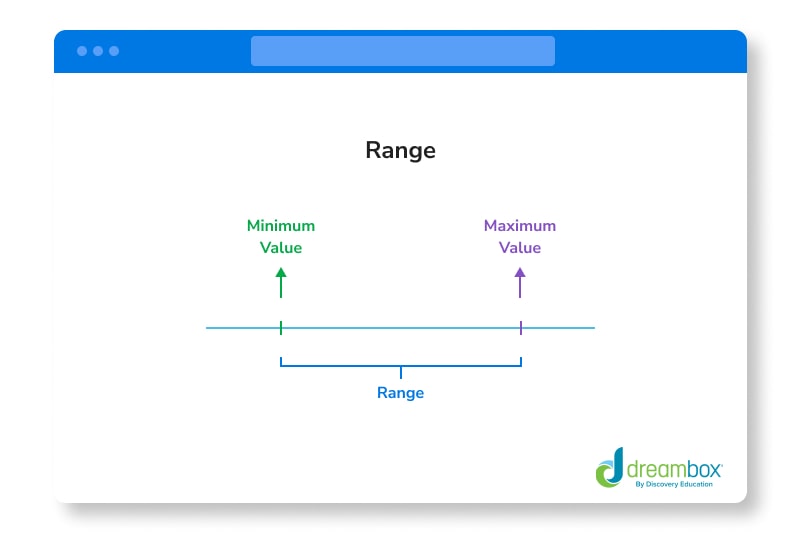What is Range in Math?
Understanding range helps students recognize patterns, compare data, and see how numbers work in the real world. Let’s learn all about range!

Author
Katie Wickliff
Published:
Nov 2025
Key takeaways
- • Range is the difference between the largest and smallest values in a data set
- • Students learn range to understand how much data varies
- • Learning range builds a foundation for more advanced statistics concepts later on
In 6th grade math, students explore more advanced ways to describe mathematical data. They build upon what they’ve already learned about collecting, organizing, recording, and analyzing information, using these skills to understand more complex concepts. One of these important concepts is range, which is a measure of spread in a set of numerical data. In this article, we’ll focus on range, discussing what it is and how to find it in a group of numbers. We’ll also share some examples of the types of range problems students might see in the classroom. Additionally, we provide several fun practice problems for your child to get comfortable finding the range in any data set. Let’s get started!
The Definition of Range in Math
In math, the range is the difference between the smallest and largest values in a set of data.
Range is often included with other mathematical descriptors, including mean, median and mode. While the mean, median, and mode are all measures of central tendency– describing a typical value within in a data set–the range tells us how spread out the values are.
Although they may not realize it, students may already use their understanding of range in daily life. For example, they might look at the difference between the lowest and highest temperatures to see how much weather fluctuates over time. Sports fans can look at the lowest and highest scores to see how much a team’s performance varies over the season. Understanding price range helps kids figure out if something they want to buy is within their budget.
Table of contents
Access more math practice with DreamBox
Get more practice on odd and even numbers with DreamBox Math
DREAMBOX MATH
Get started for FREE today!

How to find the Range
To find the range in a set of data, put the values in order from least to greatest. So, if a set of numbers looks like this:
4, 15, 24, 1, 13, 9
Students should rewrite the set to look like this:
1, 4, 9, 13, 15, 24
Now, students can more easily identify the largest value (24) and the smallest value (1).
Next, subtract the smallest value from the largest value: 24- 1 = 23
Range = 23
Range Examples
Let’s walk through a few more examples of the types of range problems your child will learn to solve in the classroom.
Example 1: The Stingers soccer team played four games in a soccer tournament. Their scores were:
4, 6, 0, 2, 9
What is the range of scores?
First, let’s put the data in order from least to greatest:
0, 2, 4, 6, 9
Now, subtract the smallest value from the largest value: 9-0 = 9
The range is 9 points
Example 2: Josie’s cat gave birth to 6 kittens. The veterinarian recorded each kitten’s weight in ounces:
3, 3, 5, 4, 2, 6
What is the range of weights?
First, let’s put the data in order from least to greatest:
2, 3, 3, 4, 5, 6
Now, subtract the smallest value from the largest value: 6-2=4
The range is 4 ounces
Start Your Free Trial
See how DreamBox can help your seventh grader with math by signing up for a free trial today.
Range Practice Problems
These problems are a great way for your student to gain extra practice calculating the range. For more focused practice, check out Dreambox Math. This interactive online program uses fun games and activities to build math skills and confidence.

17, 9, 24, 16, 7, 3, 2, 5
31, 30, 33, 30, 46, 41, 44
90, 91, 87, 84, 92, 88, 87
85, 90, 72, 89, 84, 91, 79

14, 15, 9, 10, 11, 20, 19, 19
$3, $10, $7, $28, $5
- A. What is the range of Bennett’s spending?
B. What does this range tell you about how consistent Bennett is with his spending habits?
B. A range of $25 is much larger than Bennett spends on most days. This tells us that his spending habits aren’t very consistent.
Then on cloudy, snowy days: 21 minutes, 19 minutes, 22 minutes
- A. What is the range of drive time on the sunny days?
B. What is the range of drive time on the snowy days?
C. How did the weather affect the range?
B. The range is 3.
C. Even though the snowy weather made the drives longer overall, the range stayed the same.
Take at home math practice to the next level
Empowering parents and educators to make math practice more impactful. Plus, your kids will love it.


About the Author
Katie Wickliff
Katie holds a master’s degree in Education, has over 15 years of education experience as a primary classroom teacher, and is Orton-Gillingham certified tutor. Most importantly, Katie is the mother of two primary school students, ages 8 and 11. She is passionate about maths education and firmly believes that the right tools and support will help every student reach their full potential.